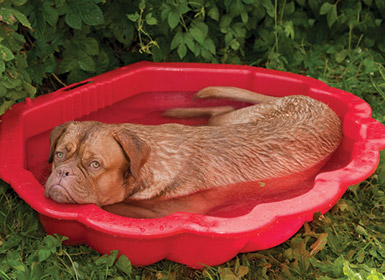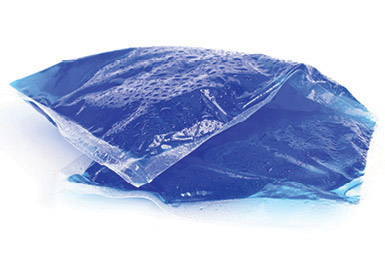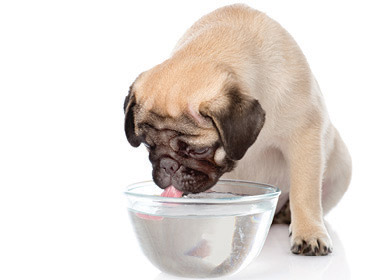Heat Stress in Dogs
Extract from 'The Dog Owners Manual' By Dr Karen Hedberg BVSc
Due to our hot climate, heat stress is quite a common problem in the hotter months. It must be remembered that this condition can be a medical emergency and failure to act quickly can result in the death of the dog.

PRE-DISPOSING FACTORS AFFECTING THE INCIDENCE OF HEAT STRESS
1. Weather - Heat stress usually occurs on very hot or moderately hot days following several consecutive hot days. The continual heat gradually lowers the dog's body reserves of sugar and salts, so that the longer a hot period lasts, the easier the heat stress can occur. In this situation, it only takes a little extra stress to set heat stress off.
2. Restricted air circulation – Heat stress can readily occur if a dog is in an area with such as a closed car, crate, tent or dog trailer, where there is inadequate through circulation of air. Dark vehicles and dog trailers absorb more heat and so will overheat more rapidly. Air conditioning in stationary cars, if left unattended, can fail quickly because of the power drain required and is also a problem.
3. Dogs that are exercising heavily in hot weather e.g. Greyhounds, are particularly at risk.
4. Black dogs absorb more heat than lighter coloured dogs (as they do not reflect the light, but absorb it), are all more prone to heat stress, as are very young and elderly dogs, as well as brachycephalic breeds.
THE DOG'S MAIN WAYS OF LOSING HEAT ARE:
1. Respiration through panting.
2. Sweating through pads. Dogs do not sweat in the same way as humans.
3. Heat loss through areas of minimal hair i.e. belly and anus.
SYMPTOMS
A dog suffering heat stress is usually very sluggish and reluctant to move.
** Respiration is extremely rapid and the mucous membranes, i.e. the gums and conjunctiva, are blue-ish.
The breathing is extremely laboured and there is usually very little salivation. The dog may vomit, stagger and collapse and if not treated quickly at this stage, it will quickly die. The rectal temperature of the dog is usually well over 40.0’C.
TREATMENT
The first priority is to cool the dog fairly rapidly.
Like humans, the most important area to cool is the head and neck, particularly under the neck. The blood going to the brain must be cooled to prevent brain damage and to settle down the respiration rate. Turn a cold water tap on full bore to wet the dog thoroughly all over starting on the head and neck, and keep the water running over the dog for a minimum of 5-10 minutes. If you have any ice or a cool pack, place some on the bridge of the nose (this is especially important on short nosed breeds) and under the neck. 

Keep the water flowing over the dog until the respiration settles down. You can wet the sides of the dog's mouth but don't expect the dog to swallow much water as it may be incapable of swallowing at this stage. Too much water in the throat at this stage will choke it.
When the dog starts to breathe in a less laboured manner, turn off the tap and keep sponging the dog down with wet towels, still paying particular attention to the neck, abdomen, anus and feet. Too rapid a temperature drop can equally cause brain damage – do not use iced water. Bath tubs are great – leave the plug in and keep the water ½ way up the sides of the dog. Take the dog's temperature once the respiration rate is reduced and keep cooling the dog until the temperature is between 39.0 and 39.5 degrees C.
As the respiration rate returns to normal, leave the dog sitting on a wet towel and give it a small amount of water to drink.
***Remember that heat rises - do not place wet towels over the dog, as it prevents the heat escaping!!!. ***
** As soon as the dog settles down take it to the nearest vet if it has not returned to normal quickly ie. if the dog is still really sluggish.
The vet will usually administer a very short acting cortisone and fluids which returns the body systems to normal and helps the dog to recover from the stress. Badly affected dogs can require oxygen administration.
It is an idea to administer fluids, either intravenously if the dog is severely affected, or orally if it is less severe. The electrolytes replace the salts that the body has lost. Weak glucose solutions with electrolytes are a help. Nothing too concentrated should be given as the idea is to rehydrate the dog by returning fluid to the body.
PREVENTION OF HEAT STRESS
Prevention of heat stress is of course far better than having affected animals.
1. Always ensure that your dogs have adequate shade and water. If the dog for some reason has to be left in a confined area ensure that:-
(a) Ventilation is more than adequate.
(b) Shade is available.
(c) Water is always available.
2. Puppies, brachycephalic breeds and old dogs are especially susceptible to heat stress. If your dog falls into these categories, you should leave a wet towel or wet newspaper over part of their living area on very hot days.
If you freeze a large dish of water, it can be left out to gradually melt during the day. Leave a sprinkler going over the shed if it can be managed or direct a fan over the animals to stir the air. If using a fan with puppies make sure it is directed over them and not down on them.
3. In hotter weather it is a good idea to give your dog electrolyte salts to help prevent heat stress.
Electrolytes are very helpful, especially after several hot days. There are various brands available and they usually contain some glucose (eg. Staminade*, Recharge*). Give one level teaspoon for average to large breeds in their food the night before expected hot days. If using a liquid electrolyte eg. Lectade* use 10-15mls of the concentrate for the same size dog.
Put the electrolytes in the food as dogs do not like it in water.
4. If travelling in hot weather, in addition to the electrolytes, always travel with plenty of water (preferably with frozen cool packs as well). If the dogs are at all distressed, wet them down and place them on wet towels. Dogs cool quickest through their feet, belly and anus. Hot air rises, so do not cover the dogs with wet towels.
5. More recently there are cool coats and cool mats that once wet, keep the dog cool. Great for dog shows and short outings. Must be careful as if the coats dry out, the dog will start to heat up rapidly ie. the coat must remain wet to be effective.
**Remember:-
1. In hot weather, ALWAYS ensure there is access to shade, good through ventilation and water at all times.
2. Heat stress can occur on a relatively mild day, especially if it has been very hot for the previous few days.
BRACHYCEPHALIC BREEDS IN HOT WEATHER
Because all brachycephalic breeds have varying degrees of the predisposing anatomical features of airway obstruction, even if it is subclinical, it is appropriate to treat all brachycephalic breeds as having the potential for upper airway obstruction. It is worth remembering that with the shorter face, the less the air will cool before it reaches the lungs.
Predisposing Risk Factors - Heat, humidity, exercise, excitement can all increase panting as the dog attempts to loose heat and cool itself. This excessive panting can in turn can produce local swelling (oedema) and further airway narrowing, increasing anxiety and body temperature; creating a vicious cycle.
TREATMENT
If panting hard, cool the dog all over by hosing the dogs down in a bath or a wading pool. Pay particular attention to the head, throat and belly. Do not attempt to make the dog swallow. Ice packs placed along the belly, under the throat will help cool the dog. Keep going for a minimum of 10-15 minutes or until the respiration rate slows down. If the dog is still having problems, get the dog to the veterinarian as soon as possible. Keep the car air conditioned with the cold air aimed directly into the face of the dog.
PREVENTION
Be aware of the temperature on a daily basis, weather forecasting generally will give a good idea well ahead of hot weather. Place your dogs on extra electrolytes in their food as this can help them cope with the heat better. Keep your dogs in cool conditions with plenty of through ventilation. In extremely hot weather, the more affected dogs may need to be kept in an air conditioned area. Fans, wet towels on the floor etc can all be useful items to leave out on hot days.
TRAVELLING
These breeds need plenty of air flow around their bodies, particularly in hot weather. If transporting by air, larger crates are needed.
## Be very careful moving brachycephalic dogs from air conditioned areas (like a car) into direct heat, as the sudden large change in temperature can stress these dogs very quickly. If travelling in an air conditioned car, turn the air conditioning off a good 10-15 minutes prior to stopping and open the windows to equalise temperatures.
This article appeared in DOGS NSW magazine, February 2017 edition.




